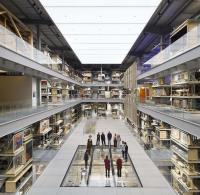Simone Veil Bridge
Bordeaux, Bègles and Floirac, Francia
The Simone Veil Bridge consists of a platform stretched across the River Garonne in Bordeaux that is 549 meters in length and 44 meters wide. The bridge provides a new linear public space for the city. It abandons any interest in style, form, and blatant structural expression in favor of a commitment to performance and an interest in potential use by the people of Bordeaux. Cars, modes of public transportation, and bicycles all have their own lanes, with the largest by far dedicated to foot traffic. The width of the bridge’s platform is doubled to create neutral, unprogrammed space that can be used for any cultural or commercial purpose, such as markets, fairs, rallies, car club meetings, and festivals for music or wine.
Today, bridges are often narrowly evaluated in terms of their technical utility and their function as tools for the expansion of the city and its periphery, largely driven by cars. The role of bridges as urban spaces in themselves has been lost. The Simone Veil Bridge rejects the current obsession with bridges as triumphant feats of engineering or aesthetic statements and recovers their dynamic urban character, to look for an alternative definition of what a twenty-first-century bridge could be. Its points of reference are bridges that are places not only for circulation but also for leisure and commercial activities—including Venice’s Rialto Bridge and incarnations of Galata Bridge across the Golden Horn in Istanbul in the nineteenth and twentieth centuries. The commingling of different forms of traffic and activities creates a contemporary boulevard that can exist in various configurations of intensity and that contributes to the metropolitan life of Bordeaux. The Simone Veil Bridge is meant to be adaptable to a range of possible future uses. It presents a literal definition for non-prescriptive place-making, and a framework for sustainability through its flexibility.
The bridge is conceived to create a unified identity for the areas on either side of the Garonne. It connects the development of Floirac on the right bank, where sculptural and functional objects are arranged to provide public amenities, with Bordeaux and Bègles on the left bank through green space that is subtly woven into the urban fabric, including with the reuse of a former highway. The bridge provides fundamental continuity for the city’s territory, through connection but also through its performance as an urban platform in a landscape.
- Architetti
- OMA - Office for Metropolitan Architecture
- Sede
- Bordeaux, Bègles and Floirac, Francia
- Anno
- 2024
- Cliente
- Bordeaux Métropole
- Team
- Rem Koolhaas (Partner in Charge), Chris van Duijn (Partner in Charge), Gilles Guyot (Project Architect), Clément Blanchet, Margarida Amial, Henry Bardsley, Denis Bondar, Kimiko Bonneau, Solène de Bouteiller, Alice Chen, Emily Crabb, Alban Denic, My-Linh Dinh, Paul Feeney, Camille Filbien, Marc-Achille Filhol, Stavros Gargaretas, Romina Grillo, Hanna Jankowska, Henri Kapynen, Min Hong Khor, Sang Woo Kim, Pierre-Jean Le Maitre, Pierre Levesque, Salma Maaroufi, Lawrence-Olivier Mahadoo, Deborah Mateo, Edward Nicholson, Ana Otelea, Jerome Picard, Ana Reis, Maria Aller Rey, François Riollot, Claudio Saccucci, Irgen Salianji, Kristin Schaefer, Sai Shu, Helene Sicsic, Lukasz Skalec, Saul Smeding, Ida Stople, Jan Szymankiewicz, Xavier Travert, Nicola Vitale
- Engineers
- WSP and Groupe EGIS
- Landscape
- Michel Desvigne Paysagiste
- Lighting
- Les éclaireurs
- Contractors (Preliminary work)
- Dubreuilh, Etchart Construction, Menard
- Contractors (Civil engineering, equipment and superstructures)
- Bouygues Travaux Publics Régions France, Pro-fond
- Contractor (Steel structure)
- Baudin Châteauneuf
- Contractor (Road and network)
- Colas, Aximum
- Contractor (Green space)
- ID Verde, Brettes Paysagiste
- Contractor (Lighting)
- SPIE City Networks



























